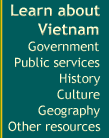The Vietnamese eating habit tends towards vegetarianism ; rice and
vegetables are the main course of the meal that may be diversified
by aquatic products. Boiling is a special way of cooking of the
Vietnamese people. Vietnamese people like a synthetic food
processing style that involves many materials and ingredients.
Today, although meat and fish are the main dishes of the meal, the
Vietnamese do not forget pickled egg-plant.
The Vietnamese preferred to wear light, thin, well-ventilated kind of
clothing that originated from plants and was suitable for such a
tropical country as Vietnam, with grey, indigo and black colours.
Men’s clothing changed from loin-cloth with bare upper half of the
body to short jackets and Vietnamese traditional trousers
(re-designed from Chinese trousers). In the past, women often
wore brassieres, skirts and four-piece long dresses that were later
modified to the modern ao dai. In general, Vietnamese women
adorned themselves subtly and secretively in a society where "virtue
is more important than appearance". Old/time clothing also paid
attention to kerchiefs, hats and belts.
The old-style Vietnamese house was related to the watery
environment (stilted house with curved roof). Then came
thatch-roofed house with clay walls, which were built mostly from
wood and bamboo. This kind of house did not stand too high to
avoid high winds and storms, and more importantly, the house
should face to the South direction to be free from hot and cold
weathers. The interior of the house was also not so spacious to
leave room for the courtyard, pond, and garden. Also, the
Vietnamese thought that "spacious home was no better than
sufficient food". Sizeable ancient architectures were often built
shrouded and in harmony with natural environment.
The traditional means of transport is waterways. Ship of all types
together with the river and the wharf, are familiar in the Vietnamese
geological and humanitarian images.
Vietnamese customs of weddings, funerals, holidays and rituals all
are attached to village community. Marriages not only reflecte the
lovers’ desire but also had to meet the interests of the family
lines,
the village; thus, the choice for future bride or bridegroom was done
very carefully, which had to go through many formalities from the
plighting ceremony, the official proposal to the bride’s family, the
wedding to the marriage tie, the ritual of sharing bridal cup of wine,
the newly-weds’ first visit to the bride’s family. Besides, the
bride
had to pay a fine in order for her to be accepted as a new member
of the village. Funeral service is also proceeded very thoroughly to
express the grief and see off the relative into the other world. The
family of the deceased does not have to take care of the service by
themselves, they are also given a helping hand by the neighbors.
Vietnam is the country of festivities which take place all year round,
especially in spring when there is little farming work. The major
festivities are Nguyen Dan (Lunar New Year ), Mid-First month ,
Han thuc (cold food) , Doan Ngo (double five) , Mid-Seventh
month , Mid-Autumn Festival, Ong tao (the god of the kitchen)
etc... Each region has its own ritual holidays, the most important of
which are agricultural rituals (such as the rituals of praying for rain,
getting down to the rice field, and new rice...) and trades’s rituals
(like the rituals of copper casting, forging, making fire crackers, and
boat racing...). Besides, there are also rituals dedicating to national
heroes and religious and cultural services (e.g, Buddhist rituals).
Ritual holidays are usually divided into two parts: the service is
carried out for blesses and thanksgivings, the holiday is the cultural
activities of the community consisting of many folk games and
contests.











